babylon.js 学习笔记(6)
接上回继续,今天继续捣腾动画,上一节咱们让汽车的轮子动了起来,回顾一下核心代码:
//轮子转动
const wheelAnimation = (scene, wheels) => {
//定义一个动画,每秒30帧,绕y轴转动
const animWheel = new BABYLON.Animation("wheelAnimation", "rotation.y",
30, BABYLON.Animation.ANIMATIONTYPE_FLOAT, BABYLON.Animation.ANIMATIONLOOPMODE_CYCLE);
//动画关键帧
const wheelKeys = [];
//起始帧
wheelKeys.push({
frame: 0,
value: 0
});
//截止帧(即:第30帧,转到360度)
wheelKeys.push({
frame: 30,
value: 2 * Math.PI
});
//设置关键帧
animWheel.setKeys(wheelKeys);
let result = [];
for (let i = 0; i < wheels.length; i++) {
//将wheel与动画关联
wheels[i].animations = [];
wheels[i].animations.push(animWheel);
//开始动画,最后的true表示循环播放
result.push(scene.beginAnimation(wheels[i], 0, 30, true));
}
return result;
}
可能有朋友要问了,这里返回的result有啥用?先卖个关子,后面再讲。
模仿这段代码,略做修改,我们就能让汽车在屏幕上动起来:
//car运动
const carAnimation = (scene, car) => {
const animCar = new BABYLON.Animation("carAnimation", "position.x",
30, BABYLON.Animation.ANIMATIONTYPE_FLOAT, BABYLON.Animation.ANIMATIONLOOPMODE_CYCLE);
//动画关键帧
const carKeys = [];
//起始帧
carKeys.push({
frame: 0,
value: -1
});
carKeys.push({
frame: 30,
value: -0.9
});
//截止帧(即:第120帧,走到x=8)
carKeys.push({
frame: 120,
value: 0.9
});
carKeys.push({
frame: 150,
value: 1
});
//设置关键帧
animCar.setKeys(carKeys);
car.animations = [];
car.animations.push(animCar);
//开始动画
return scene.beginAnimation(car, 0, 150, true);
}
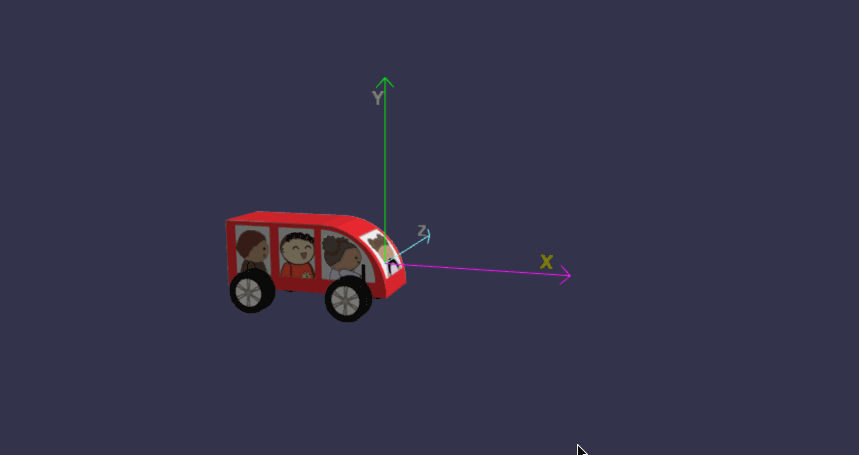
一、如何控制动画暂停/播放?
接下来说说scene.beginAnimation 返回值有啥用?根据官方文档描述,这个返回对象Animatable提供了几个有用的方法:
- pause()
- restart()
- stop()
- reset()
利用这些方法,接下来加点鼠标互动:
- ALT+鼠标单击,暂停/继续播放 汽车运动;
- SHIFT+鼠标单击,暂停/继续播放 车轮转动
//声明2个变量,方便控制动画
let wheelAnimatables, carAnimatable;
const createScene = () => {
const scene = new BABYLON.Scene(engine);
...
wheelAnimatables = wheelAnimation(scene, wheels);
carAnimatable = carAnimation(scene, car);
...
return scene;
}
...
window.addEventListener("click", (e) => {
if (e.altKey) {
if (carAnimatable._paused) {
carAnimatable.restart();
}
else {
carAnimatable.pause();
}
}
if (e.shiftKey) {
let first = wheelAnimatables[0];
if (first._paused) {
wheelAnimatables.forEach(element => {
element.restart();
});
}
else {
wheelAnimatables.forEach(element => {
element.pause();
});
}
}
});
在线地址:https://yjmyzz.github.io/babylon_js_study/day06/01.html
为了方便后面复用这个小汽车,我们把它在playground上导出为babylon文件(参考前文提到的做法),核心代码如下:
const createScene = () => {
const scene = new BABYLON.Scene(engine);
const camera = new BABYLON.ArcRotateCamera("camera", -Math.PI / 2, Math.PI / 2.5, 2, new BABYLON.Vector3(0, 0, 0));
camera.attachControl(canvas, true);
const light = new BABYLON.HemisphericLight("light", new BABYLON.Vector3(1, 1, 0));
const car = buildCar();
const wheels = buildWheels(car);
car.rotation.x = -Math.PI / 2;
wheelAnimation(scene, wheels);
return scene;
}
const buildCar = () => {
//base
const outline = [
new BABYLON.Vector3(-0.3, 0, -0.1),
new BABYLON.Vector3(0.2, 0, -0.1),
]
//curved front
for (let i = 0; i < 20; i++) {
outline.push(new BABYLON.Vector3(0.2 * Math.cos(i * Math.PI / 40), 0, 0.2 * Math.sin(i * Math.PI / 40) - 0.1));
}
//top
outline.push(new BABYLON.Vector3(0, 0, 0.1));
outline.push(new BABYLON.Vector3(-0.3, 0, 0.1));
//car face UVs
const faceUV = [];
faceUV[0] = new BABYLON.Vector4(0, 0.5, 0.38, 1);
faceUV[1] = new BABYLON.Vector4(0, 0, 1, 0.5);
faceUV[2] = new BABYLON.Vector4(0.38, 1, 0, 0.5);
//car material
const carMat = new BABYLON.StandardMaterial("carMat");
carMat.diffuseTexture = new BABYLON.Texture("https://yjmyzz.github.io/babylon_js_study/assets/img/car.png");
//back formed automatically
const car = BABYLON.MeshBuilder.ExtrudePolygon("car", { shape: outline, depth: 0.2, faceUV: faceUV, wrap: true });
car.material = carMat;
return car;
}
const buildWheels = (car) => {
//wheel face UVs
const wheelUV = [];
wheelUV[0] = new BABYLON.Vector4(0, 0, 1, 1);
wheelUV[1] = new BABYLON.Vector4(0, 0.5, 0, 0.5);
wheelUV[2] = new BABYLON.Vector4(0, 0, 1, 1);
//car material
const wheelMat = new BABYLON.StandardMaterial("wheelMat");
wheelMat.diffuseTexture = new BABYLON.Texture("https://yjmyzz.github.io/babylon_js_study/assets/img/wheel.png");
const wheelRB = BABYLON.MeshBuilder.CreateCylinder("wheelRB", { diameter: 0.125, height: 0.05, faceUV: wheelUV })
wheelRB.material = wheelMat;
wheelRB.parent = car;
wheelRB.position.z = -0.1;
wheelRB.position.x = -0.2;
wheelRB.position.y = 0.035;
const wheelRF = wheelRB.clone("wheelRF");
wheelRF.position.x = 0.1;
const wheelLB = wheelRB.clone("wheelLB");
wheelLB.position.y = -0.2 - 0.035;
const wheelLF = wheelRF.clone("wheelLF");
wheelLF.position.y = -0.2 - 0.035;
const wheels = [];
wheels.push(wheelRB);
wheels.push(wheelRF);
wheels.push(wheelLB);
wheels.push(wheelLF);
return wheels;
}
//轮子转动
const wheelAnimation = (scene, wheels) => {
//定义一个动画,每秒30帧,绕y轴转动
const animWheel = new BABYLON.Animation("wheelAnimation", "rotation.y",
30, BABYLON.Animation.ANIMATIONTYPE_FLOAT, BABYLON.Animation.ANIMATIONLOOPMODE_CYCLE);
//动画关键帧
const wheelKeys = [];
//起始帧
wheelKeys.push({
frame: 0,
value: 0
});
//截止帧(即:第30帧,转到360度)
wheelKeys.push({
frame: 30,
value: 2 * Math.PI
});
//设置关键帧
animWheel.setKeys(wheelKeys);
for (let i = 0; i < wheels.length; i++) {
//将wheel与动画关联
wheels[i].animations = [];
wheels[i].animations.push(animWheel);
//开始动画,最后的true表示循环播放
scene.beginAnimation(wheels[i], 0, 30, true);
}
}
结合先前画的房屋,可以让小汽车在房屋之间动起来:
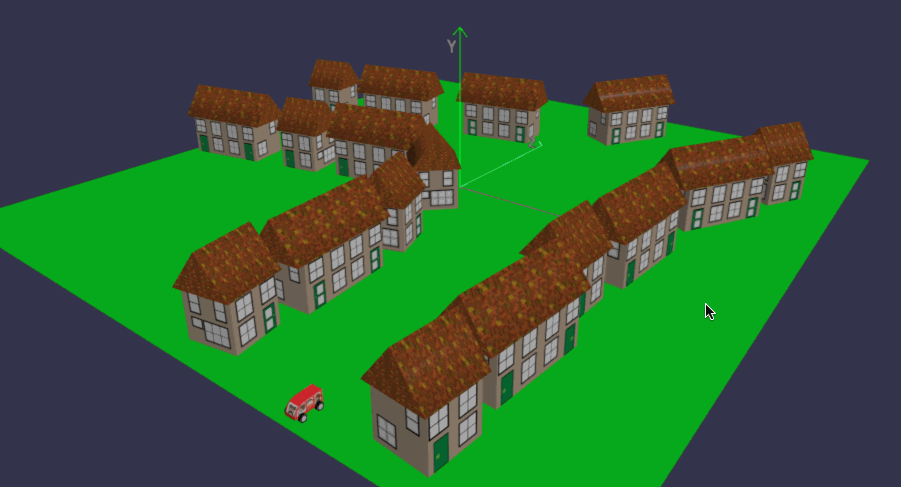
在线地址:https://yjmyzz.github.io/babylon_js_study/day06/02.html (加载的资源比较多,网页首次打开可能比较慢)
二、如何实现复杂的运动轨迹?
2.1 理解movePOV
babylon.js提供了movePOV(rightSpeed, upSpeed, forwardSpeed)方法,可以让对象 朝右(x轴负方向)、朝上(z轴正方向)、朝前(z轴负方向) 运动。
下面分别演示一下,基本代码如下:
const createScene = () => {
const scene = new BABYLON.Scene(engine);
const camera = new BABYLON.ArcRotateCamera("camera", -Math.PI / 2, Math.PI / 2.5, 15, new BABYLON.Vector3(0, 0, 0));
camera.attachControl(canvas, true);
const light = new BABYLON.HemisphericLight("light", new BABYLON.Vector3(1, 1, 0));
BABYLON.SceneLoader.ImportMeshAsync("him", "../assets/glb/", "dude.babylon").then((result) => {
var dude = result.meshes[0];
dude.scaling = new BABYLON.Vector3(0.02, 0.02, 0.02);
scene.beginAnimation(result.skeletons[0], 0, 100, true, 1.0);
//向前运动
const rightSpeed = 0, upSpeed = 0, forwardSpeed = 0.01;
let distance = 0;
//控制下一帧的行为
scene.onBeforeRenderObservable.add(() => {
//让人物动起来
dude.movePOV(rightSpeed, upSpeed, forwardSpeed);
distance += 0.002;
if (distance > 1) {
//走的距离>1地,复位
distance = 0;
dude.position = BABYLON.Vector3.Zero();
}
});
});
showAxis(4, scene);
return scene;
}
向前(z轴负方向):
注:此处的向前,是从人物自身的视角来看的,从观察者(即电脑前的我们)角度来看,即为向我们走来。
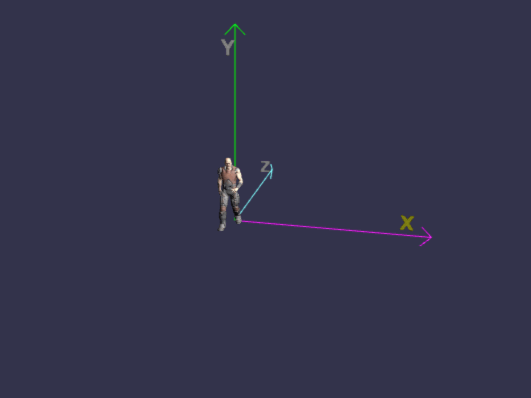
向右(x轴负方向):
//向右运动 const rightSpeed = 0.01, upSpeed = 0, forwardSpeed = 0.00;

注:由于人物动画走路朝向的设计原因,仅设置rightSpeed有值,会让人横向移动(类似螃蟹),有点奇怪(马上会讲到rotate方法,可以解决这个问题)
向上(Y轴正方向):
//向上运动 const rightSpeed = 0, upSpeed = 0.01, forwardSpeed = 0.00;

2.2 理解rotate
前进过程中如何转向呢?回想下开汽车时,我们用方向盘来转向,babylon.js中自然也有类似方法,即:rotate方法
BABYLON.SceneLoader.ImportMeshAsync("him", "../assets/glb/", "dude.babylon").then((result) => {
var dude = result.meshes[0];
dude.scaling = new BABYLON.Vector3(0.02, 0.02, 0.02);
scene.beginAnimation(result.skeletons[0], 0, 100, true, 1.0);
//向前运动
const rightSpeed = 0, upSpeed = 0, forwardSpeed = 0.01;
let distance = 0, turnFlag = false;
//控制下一帧的行为
scene.onBeforeRenderObservable.add(() => {
//让人物动起来
dude.movePOV(rightSpeed, upSpeed, forwardSpeed);
distance += 0.002;
//走到0.5距离时,右转90度
if (!turnFlag && Math.abs(distance - 0.5) <= 0.000001) {
dude.rotate(BABYLON.Axis.Y, Math.PI / 2, BABYLON.Space.LOCAL);
turnFlag = true;
}
if (distance > 1) {
//走的距离>1地,复位
distance = 0;
dude.position = BABYLON.Vector3.Zero();
dude.rotation = BABYLON.Vector3.Zero();
turnFlag = false;
}
});
});
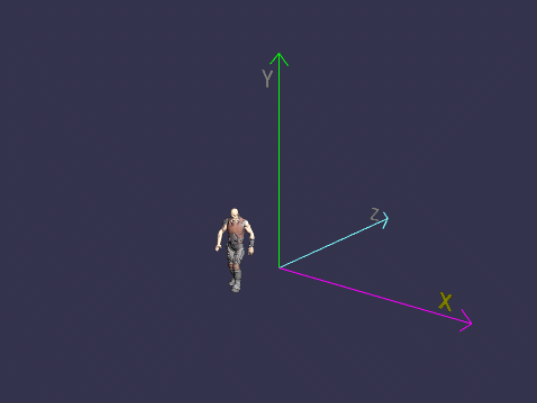
在线地址 :https://yjmyzz.github.io/babylon_js_study/day06/03.html
3 生成复杂运动轨迹
结合movePOV 以及rotate,就能实现相对较为复杂的运动轨迹
const createScene = () => {
const scene = new BABYLON.Scene(engine);
const camera = new BABYLON.ArcRotateCamera("camera", -Math.PI / 2, Math.PI / 2.5, 15, new BABYLON.Vector3(0, 0, 0));
camera.attachControl(canvas, true);
const light = new BABYLON.HemisphericLight("light", new BABYLON.Vector3(1, 1, 0));
//画1个正方形(辅助观察人物运动路径)
const squarePoints = [new BABYLON.Vector3(-2, 0, 2),
new BABYLON.Vector3(2, 0, 2),
new BABYLON.Vector3(2, 0, -2),
new BABYLON.Vector3(-2, 0, -2),
new BABYLON.Vector3(-2, 0, 2)];
const square = BABYLON.MeshBuilder.CreateLines("square", { points: squarePoints });
//走距离dist后,转方向trun(角度)
const trunPoint = function (turn, dist) {
this.turn = turn;
this.dist = dist;
}
//运动轨迹(关键转向点)
//注:因本例中的人物原型太大,加载后缩小处理了,所以这里的距离也要回应缩小(即:*0.2)
const track = [
new trunPoint(Math.PI / 2, 4 * 0.2),
new trunPoint(Math.PI / 2, 8 * 0.2),
new trunPoint(Math.PI / 2, 12 * 0.2),
new trunPoint(Math.PI / 2, 16 * 0.2)
]
BABYLON.SceneLoader.ImportMeshAsync("him", "../assets/glb/", "dude.babylon").then((result) => {
var dude = result.meshes[0];
dude.scaling = new BABYLON.Vector3(0.02, 0.02, 0.02);
dude.position = new BABYLON.Vector3(2, 0, 2);
scene.beginAnimation(result.skeletons[0], 0, 100, true, 1.0);
//向前运动
const rightSpeed = 0.00, upSpeed = 0.00, forwardSpeed = 0.01;
//distance记录走过的距离,p为track中转向点的下标(即:第几个转向点)
let distance = 0, p = 0;
//控制下一帧的行为
scene.onBeforeRenderObservable.add(() => {
//让人物动起来
dude.movePOV(rightSpeed, upSpeed, forwardSpeed);
distance += 0.002;
//判断关键转向点
console.log(distance);
if (distance > track[p].dist) {
dude.rotate(BABYLON.Axis.Y, track[p].turn, BABYLON.Space.LOCAL);
p += 1;
p %= track.length;
if (p === 0) {
//走到最开始的位置时,复位
distance = 0;
dude.position = new BABYLON.Vector3(2, 0, 2);
dude.rotation = BABYLON.Vector3.Zero();
}
}
});
});
showAxis(4, scene);
return scene;
}
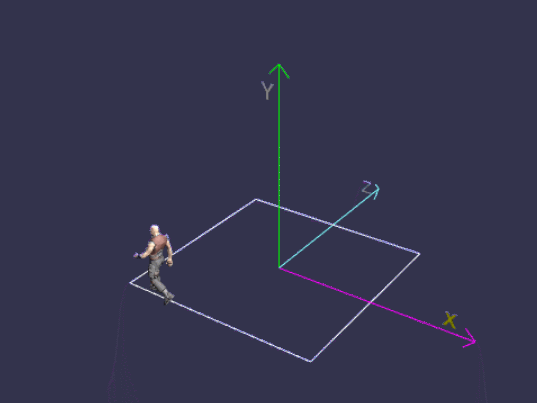
在线地址:https://yjmyzz.github.io/babylon_js_study/day06/04.html
4、碰撞检测
每个mesh对象在babylon.js中实际占据着一块矩形立体空间
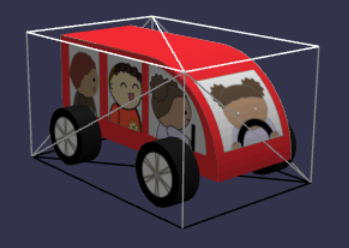
当2个对象碰撞到时,只要这2个立体空间有重叠即为发生了碰撞,对应的方法为 intersectsMesh,下面给1个简单的演示:
BABYLON.SceneLoader.ImportMeshAsync("", "../assets/glb/", "car.babylon").then((result) => {
var car1 = scene.getMeshByName("car");
car1.position = new BABYLON.Vector3(-6, 0, 0);
car1.scaling = new BABYLON.Vector3(4, 4, 4);
const wheelRB = scene.getMeshByName("wheelRB");
const wheelRF = scene.getMeshByName("wheelRF");
const wheelLB = scene.getMeshByName("wheelLB");
const wheelLF = scene.getMeshByName("wheelLF");
let wheels = [wheelRB, wheelRF, wheelLB, wheelLF];
let wheelAnimatables = [];
for (let i = 0; i < wheels.length; i++) {
wheelAnimatables.push(scene.beginAnimation(wheels[i], 0, 30, true));
}
const animCar = new BABYLON.Animation("carAnimation", "position.x", 30, BABYLON.Animation.ANIMATIONTYPE_FLOAT, BABYLON.Animation.ANIMATIONLOOPMODE_CYCLE);
const carKeys = [];
carKeys.push({
frame: 0,
value: -6
});
carKeys.push({
frame: 120,
value: 6
});
animCar.setKeys(carKeys);
car1.animations = [];
car1.animations.push(animCar);
let carAnimable = scene.beginAnimation(car1, 0, 120, true);
//复制出第2辆车,挡在路上
var car2 = car1.clone("car2");
car2.position = new BABYLON.Vector3(2, 0, 0.4);
car2.rotation.y = Math.PI;
car2.scaling = car1.scaling;
//注:第2辆车刚复制出来的瞬间,位置与第1辆车就重合了,会导致一出场就碰了,因此要借助ready把首次碰排除掉
let ready = false;
//控制下一帧的行为
scene.onBeforeRenderObservable.add(() => {
//发生碰撞
if (car1.intersectsMesh(car2)) {
if (!ready) {
ready = true;
return;
}
if (ready){
//停止动画
carAnimable.stop();
//模拟第1辆车,被撞飞
car1.rotate(BABYLON.Axis.Y, Math.PI*0.4, BABYLON.Space.LOCAL);
car1.position.x -= 0.2;
car1.position.y += 0.5;
return;
}
}
});
});

在线地址 : https://yjmyzz.github.io/babylon_js_study/day06/05.html
参考文档:
https://doc.babylonjs.com/features/introductionToFeatures/chap3/walkpath
https://doc.babylonjs.com/features/introductionToFeatures/chap4/mesh_intersect
出处:http://yjmyzz.cnblogs.com
本文版权归作者和博客园共有,欢迎转载,但未经作者同意必须保留此段声明,且在文章页面明显位置给出原文连接,否则保留追究法律责任的权利。



 浙公网安备 33010602011771号
浙公网安备 33010602011771号